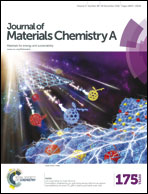An ether bridge between cations to extend the applicability of ionic liquids in electric double layer capacitors†
Abstract
In this study, without the use of any organic solvents, the performance of an ionic liquid (IL) electrolyte, 1-ethyl-3-methylimidazolium bis(trifluoromethanesulfonyl) imide (EMIm-TFSI), is improved by linking some of the EMIm+ cations with an ether bridge (–O(CH2)2O–) to form C6O2(MIm)22+ dications in the IL. After replacing 5% of cations with dications, the resultant IL (EM-di5) exhibits a lowered freezing temperature and an amorphous ion arrangement. Spectroscopic analyses clarify that introducing dications reduces the interionic interaction in the IL. When carbon-based electric double-layer capacitors (EDLCs) are assembled using the ILs, the EM-di5 EDLC exhibits lower ion transport resistance and a wider operation temperature range (60 to −20 °C) than does the EMIm-TFSI EDLC (60 to 0 °C). The EM-di5 EDLC presents high electrode capacitances of 200 and 160 F g−1 over a 3.5 V window at 25 and −20 °C, respectively, because the presence of dications facilitates ion penetration into the micropores. The EM-di5 EDLC delivers a specific energy of 70 W h kg−1 at a specific power of 1.3 kW kg−1 (on total carbon mass) at −20 °C. This study presents a molecular-architecture strategy to extend the applicability of ILs in EDLCs to low-temperature environments with improved capacitance.


 Please wait while we load your content...
Please wait while we load your content...